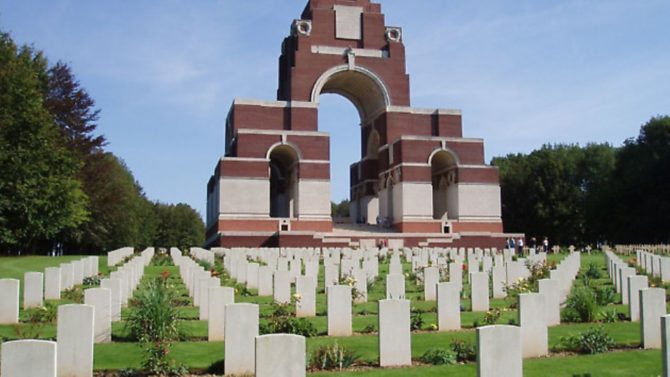7 eye-opening World War I museums in northern France

To commemorate the centenery of the First World War, museums and memorials in northern France are holding special exhibitions and events to teach visitors about the war and its infamous battles. Here are 7 you should visit

Thiepval Memorial to the Missing of the Somme, Thiepval
The Thiepval Memorial to the Missing of the Somme bears the names of the 73,357 British and South African men who died in Somme between July 1916 and March 1918 and have no known grave. There is also a small cemetery the graves of Commonwealth and French soldiers and you can learn more about the infamous Battle of the Somme in July 1916 in the nearby visitor centre. Exhibitions in English, French and German give an overview of the First World War as well as events during the Battle of the Somme. The visitor centre is open every day, except Christmas and New Year, and admission is free.

Musée Somme 1916, Albert
The Musée Somme 1916, in Albert, is set in what was originally the crypt beneath the Basilique Notre-Dame de Brebières. These tunnels are 10 metres below ground and 250 metres long and were used as air raid shelters in the Second World War. The tunnels now house recreated sleeping quarters military operations rooms, hospital wards, store rooms, a sniper position and a German trench from the Battle of the Somme. There are also cases showing weapons and other war materials found in the surrounding fields and trenches after the war.

Mémorial Verdun
After two years of extensive renovation and expansion the Mémorial Verdun museum reopened in February 2016 to mark the centenary of the start of the Battle of Verdun. Located on the former battlefield, the museum is close to the village of Fleury which was completely destroyed during the battle which was the longest battle in WWI, lasting from 21 February until 18 December 1916 and claimed the lives of an estimated 800,000 men. The museum tells the story of the battle from both French and German soldiers’s perspectives and exhibits include photographs, eyewitness accounts and audiovisual clips.

Musée de la Grande Guerre, Meaux, near Paris
The Musée de la Grande Guerre (Museum of the Great War) in Meaux was opened in 2011 and uses technology to reconstruct a battlefield with projections, sound effects and interactive displays. The permanent exhibition looks at all aspects of the war including technological developments, the role of women in the war, life in the trenches, the role of America and the war strategies of leading commanders. The museum also sets WWI in context with explanations of the tensions that contributed to the onset of war and the lasting effects of the war. The museum is closed Tuesdays and from 4-22 January and admission costs €10.

Historial de La Grande Guerre, Péronne
The Historial de la Grande Guerre museum in Péronne, in Somme, was opened in 1992 and is an international museum designed to show the experiences of France, Britain and Germany in the First World War. There are explanations of the conflict, its origins and legacy as well as exhibitions to show what life was like for a soldier on the front line and for civilians caught up in the war. To experience the harsh impact of war, go to the Central Room where life-size and larger photographs of people from all round the world before the outbreak of hostilities are contrasted with Der Krieg (War), a series of powerful prints by the German artist Otto Dix. He was deeply affected by his experiences in the trenches and these nightmarish, pain-racked images were his attempt to force society to face up to what it had allowed to happen. It does not make easy viewing, but brings home the reality of war and its emotional effects.

Le Musée de la Bataille de Fromelles, Nord
The Musée de la Bataille de Fromelles in Fromelles, near Lille, opened in 2014 to commemorate the Battle of Fromelles on 19 and 20 July 1916, which claimed the lives of more than 1,700 Australian soldiers and 500 British troops, and left nearly 5,000 other casualties. The attack was mounted in a failed attempt to draw the Germans away from the bigger battle on the Somme. Although the tragedy was eclipsed in Britain by the slaughter on the Somme, Fromelles is remembered in Australia as the worst 24 hours in its military history. The museum displays a collection of uniforms, equipment, photos, documents and battlefield objects and is next to Pheasant Wood Cemetery where the graves of 250 Allied soldiers can be found.
www.musee-bataille-fromelles.fr
Carrière Wellington, Arras
The Carrière Wellington (Wellington Quarry) museum in Arras tells the story of the lead up to the Battle of Arras on 9 April 1917. The Allied troops decided to create a huge network of rooms and tunnels to hide thousands of troops near the German front line, ready to launch an attack. The museum is underground, in these tunnels and quarries and commemorates the soldiers who fought in the battle and the New Zealand tunnelers who dug the tunnels. A guided tour along the tunnels reveals film presentations, graffiti and relics from the troops. Also visit the Vimy Ridge memorial just 10km away which commemorates the Canadian soldiers who died capturing the ridge in 1917 as part of the Battle of Arras.
Like this? You might enjoy:
Share to: Facebook Twitter LinkedIn Email


